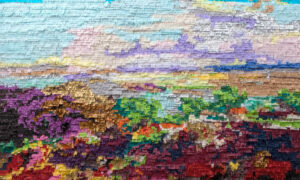Tilting the Basin 2017
Curated by Joanne Northrup and Michele Quinn
Nevada Museum of Art, August 05, 2016 – October 23, 2016
The cover on a VHS copy of the 1997 movie “Nevada” shows a solitary woman wandering along a sand-swept freeway, framed by sagebrush and asphalt, a classic image of the area, largely desert and semi-arid.
The cover on a VHS copy of the 1997 movie Nevada shows a solitary woman wandering along a sand-swept freeway, framed by sagebrush and asphalt, a classic image of the area, largely desert and semi-arid. But the first European explorers of the region, the Spaniards, called it Nevada, which means snowy, because of the white capped mountains. And so, in many ways, it truly is the Silver State.
The Great Basin formed as a result of the Pacific plate pulling away from the continental plate, the crust stretching as blocks broke loose and dropped to form mountain ranges and 90 basins (or valleys) that flowed inland and, in time, filled, teeming with rich sediment. The exhibit, Tilting the Basin, showcases this bounty, as over 30 artists who live and work in Nevada define the land. Opening in Reno at the Nevada Museum of Art and later in Las Vegas, it pours forth thanks to co-curators Joanne Northrup and Michele Quinn, respectively based North and South, who know their way and share clear visions of the road ahead.
Tilting the Basin 2017
Curated by JoAnne Northrup
Nevada Museum of Art, July 29, 2016 – January 8, 2017
The Nevada Museum of Art commissioned New York-based artist Anthony McCall to create a new “solid light” sculpture titled Swell, which represents a change of direction for his immersive light installations. Inspired by the movement of bodies of water, this commission draws explicit connections between wave forms the artist used in his earlier digital works, and the liquid motion of floating objects.
A McCall solid light work is best understood as a sculptural object made of light, modified and shaped over time. Each installation begins as a simple line drawing, which is set in motion using an animation program. Once the animation is aligned to a physical gallery space, mist from a haze machine makes the projected light beams visible. The various stages of movement are frozen in sequential “footprint” drawings, a group of which are on view nearby.
Upon entering this darkened gallery, visitors will discover two projected beams of light passing diagonally through the space. The light beams converge as a two-dimensional line drawing on the opposite wall. These intersecting forms, one a simple flat blade and the other an incomplete cone, create surprising topologies of shifting, translucent, three-dimensional spaces.
© Nevada Museum of Art 2016

